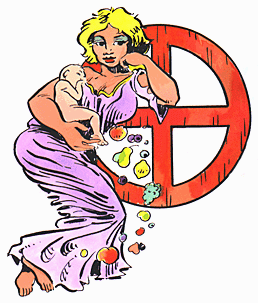Earth, Words from the Myths
(Gaia, Earth goddess of the ancient Greeks, she was called Gaea, Terra Mater, "Earth Mother" by the Romans; third planet from the sun)
As the earth mother, her symbol is the Greek sign for sphaira, "sphere"


- The Greeks called her Gaia while the Romans referred to her as Gaea, Terra, and Tellus.
- The Greeks had a theory that the earth was the center of the universe and that the Sun, Moon, and planets revolved around her (a geocentric universe).
- According to Greek mythology, in the beginning the Earth was not full of loveliness, as it is now.
- No trees waved their leafy branches; no flowers blossomed in the valleys; no grass grew on the plains; no birds flew through the air.
- All was silent, bare, and motionless.
- Eros, the first to be aware of these deficiencies, seized his life-giving arrows and pierced the cold Earth.
- Immediately the brown surface was covered with rich green; birds of many colors flew through the foliage of the new-born forest trees; animals of all kinds roamed over the grassy plains; and swift-darting fishes swam in the clear streams.
- All was now life, joy, and motion.
- Gaea, roused from her apathy, admired all that had been done to beautify her; and, wanting to crown and complete the work so well begun, she created Uranus (Heaven).
- This version of the creation of the Earth, although one of many current with the Greeks and Romans, is considered the one most generally adopted.
- The Greeks were convinced that their land occupied the central position on the Earth, and that Mount Olympus, the legendary abode of their gods, was placed in the exact center.
- Earth and its satellite, the Moon, follow a slightly oval-shaped path around the Sun.
- This causes Earth at one point to travel 2 500 000 km farther from the Sun than its average distance.
- Despite this variance, Earth stays within a region of tolerance called the “ecosphere”.
- In this safety zone, that roughly extends from the orbit of Venus to that of Mars, temperatures never get too high nor too low to support her varied forms of life.
- If her orbit changed and carried her closer to the Sun, she would roast and life as it now exists would be destroyed.
- Swinging too far away from the Sun, she would freeze into a ball of ice.
- Earth’s tilt causes the seasons. When the North Pole slants toward the Sun, the Northern Hemisphere has summer while the Southern Hemisphere has winter.
- Although earth is then farthest from the Sun, the sunlight is less slanted and lasts longer.
- Winter comes to the Northern Hemisphere when the North Pole tilts away from the Sun and the Southern Hemisphere has its summer.
- A magnetic field acts as Earth’s shield against the solar wind, creating a region called the magnetosphere.
- The wind carries deadly, electrically charged particles as it streams outward from the Sun.
- Some particles are trapped in the Van Allen Belts, two bands that circle Earth.
- Earth has one natural satellite, the Moon.
- The Moon is an airless world with a diameter almost one-fourth that of Earth.
- In the Solar System, only Pluto, with its companion Charon, has a satellite so close to its own size.
- The Earth-Moon system is considered a double planet.
Her first-born Earth produc'd,
Of like immensity, the starry Heaven;
That he might sheltering compass her around
On every side.
Of like immensity, the starry Heaven;
That he might sheltering compass her around
On every side.
A few scientific facts about the Earth:
Available for further study: the geo unit of "earth" words.
 The page of planet images.
The page of planet images.
